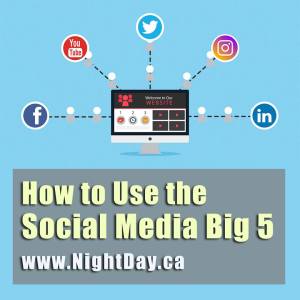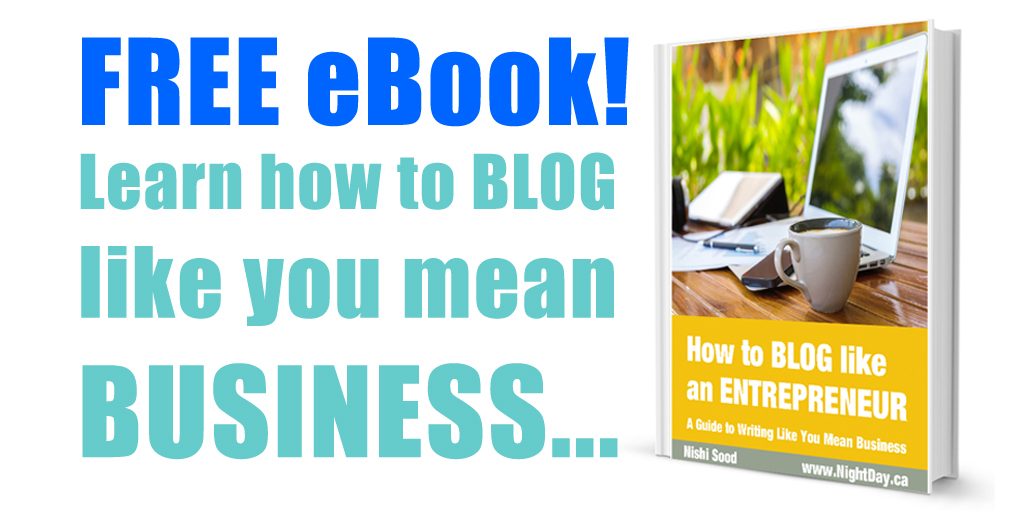How to Use the Social Media Big 5
 If you are an entrepreneur owner using social media to promote your business, you need to know about the Social Media Big 5.
If you are an entrepreneur owner using social media to promote your business, you need to know about the Social Media Big 5.
Different digital marketers are going to have varying opinions, but for the most part, the majority will agree the Big 5 are: Facebook, Twitter, LinkedIn, YouTube and Instagram.
If you’re wondering about Pinterest and Snapchat, they each get an honorary mention, at least in my book.
It’s important to be aware of the Social Media Big 5 because when you’re an entrepreneur, your time and resources are finite. You need to maximize your ROI (return on investment) wherever and whenever possible.
By focusing your social media marketing efforts on the Big 5, you will do just that.
The Big 5 are social media’s current heavy-hitters because they have proven track records as powerful marketing tools for business owners.
These social media platforms aren’t disappearing any time soon, and pretty much everyone and anyone you are trying to engage is on at least one of the Big 5.
Like members of a superhero mega team, each member of the Big 5 boasts its own individual features and characteristics – no two platforms are alike.
Here is a brief run-down of the unique features of each Big 5 social site you’ll want to leverage when marketing your business:
Pretty much everyone alive and their grandad is on Facebook these days, so it’s a logical move to get your business on there as well.
Just make sure you get both a personal profile and a business page. You require a personal profile in order to create a business page – there is no working around this, it is a requirement from Facebook.
But you can still use your personal profile to promote your business to friends and close colleagues if you friend them on Facebook, but be aware that there are some restrictions. Also, Facebook sort of frowns upon it.
Just make sure you fully understand the nuances and differences between running a Facebook business page and a personal profile. They are two different things that operate differently.
Also, do not restrict your posts to just links and written content on Facebook. Photos and videos perform very well on Facebook – better than links. Learn how to use tags and hashtags on Facebook too – these may seem like frivolous things, but if you learn how to use them properly, you’ll gain more visibility on Facebook.
Finally, learn how to read the analytics that Facebook provides for you if you have a business page. Facebook provides a wealth of information (for free!) that can help you understand your target audience better.
For instance, a very useful analytic that Facebook provides is when your Facebook audience is most often online.
Twitter is a great platform to broadcast your business blog, if you have one.
To get the most out of Twitter, make sure you’re engaging and interacting with other people on Twitter.
Just make sure your blogs are genuinely helpful and that your headlines are catchy. You need to become an expert on delivering big bursts of “wow” in 140 characters or less if you’re going to dominate Twitter.
Use an URL-shortener (like tinyurl.com, bit.ly, or ow.ly) to save characters and track the clicks you are getting on you tweets. Tracking your clicks will give you feedback on what’s working and what isn’t.
Also, learn how to use hashtags on Twitter.
Don’t forget – you can also attach a photo or video to your tweet so that it gets more visibility.
LinkedIn was originally a job-search site, and it still is to this day. However, it’s evolved immensely since its creation and now entrepreneurs can use this platform as a networking and business marketing tool, even though they’re not typically looking for a job in the traditional sense.
You might be wondering why a business owner needs to upload a resume and educational history and all the things LinkedIn asks for in order to complete a profile. I mean, when was the last time you even used a resume, right? Entrepreneurs don’t have resumes! Put it this way…
If a potential client is thinking of doing business with you, often times, they will do a Google search on your name and do a little background check on you. (Don’t act so shocked, we’ve all done this.) Search engines like Google love LinkedIn profiles, and they rank high in searches. So it’s really in your best interests to have a complete and well-written LinkedIn profile for this reason alone. Just make sure you complete your LinkedIn profile as a business owner, and not as an employee candidate.
Also, LinkedIn is great for connecting with other business owners. You can find referral partners, suppliers, subcontractors, and potential clients if you learn how to network properly as a business on LinkedIn.
And finally, LinkedIn has a free blog feature. FREE! Maintaining a business blog is an excellent way to market your business and brand yourself as an expert in your industry. LinkedIn’s blog feature is very simple to use; there’s really no excuse for any business owner to not have a business blog anymore. Did I mention it’s FREE?
YouTube
The reason why YouTube is on the Big 5 list is because it is a VERY powerful search engine.
It’s the second-most powerful search engine in existence, actually – second only to Google.
And… it’s owned by Google.
So if you want your content to rank high on the most powerful search engine in the world, you need to be making quality business videos and they need to be on YouTube. The end.
You can maximize your YouTube efforts by learning how to use keywords and tags and then incorporating them in your YouTube videos’ titles and descriptions.
Relatively speaking, Instagram is the new kid on the block within the Big 5.
Do not underestimate its power, though. Instagram is an incredibly effective business platform.
Instagram is more engaging than Facebook and Twitter COMBINED.
Everyone knows that having a successful Instagram marketing campaign is contingent on having a steady stream of fresh, beautiful, engaging images in your stream.
What often gets overlooked, however, is the fact that you can upload short videos to Instagram too.
Also, I’ve mentioned the importance of using hashtags a couple of times in this article, but if there is one social media platform where you will benefit tremendously by using hashtags, it’s Instagram. You’re allowed to use up to 30 hashtags per post – use 30 whenever you can!
Instagram has recently rolled out a business account status that gives entrepreneurs access to some new features and analytics, in a similar way that Facebook does for business page owners (not surprisingly, Instagram is owned by Facebook).
It will be interesting to see how Instagram evolves as a business marketing tool.
Did you find this post helpful? Got a question about social media marketing? Leave me a comment below!
If you’re ready to take your business blog to the next level, check out my FREE eBook, “How To Blog Like An Entrepreneur” here…

I’m currently using two of the Big 5 for my social media efforts. Over the next few weeks, I’m going to focus on integrating LinkedIn – a platform that I stepped back from for no good reason other than, as you mentioned, my resource of time is limited as an entrepreneur.
Thanks for this summary/overview. Now I can map my social media strategy with a bit more insight and not feel so overwhelmed.
Great overview.
I’m primarily on Facebook, with Twitter as a distant second.
Still learning the purpose and application of the other three. But I’m getting there. Your guide is a great summary of where to focus my attention.
I really like this quick in your face guide for the big 5. As an entrepreneur, I am constantly looking to improve and grow my social media angle in my business. This is a reminder that I am on track and I learned something new from your Facebook section – woo-hoo!
This has really helped me hone in on which of the Big 5 Social Media gigs I should be devoting my time to. Love the tips on photos/videos for Facebook posts on my business page – those are definitely the hot posts in my analytics. Working on Instagram 😉 Great tips here on helping me understand it’s potential for business.
Great overview of the “Big 5” social media platforms available to support our entrepreneurial efforts. Especially like the tip on using the Facebook tool for finding out when our target audiences are on line.
Thank you for the “Big 5 Tips”. I used 4 out of the 5, I didn’t realize that LinkedIn would be one of the best sources for promoting my business. I’ll definitely look into that in the near future.
YouTube and Facebook are the ones I use the most. I still have to learn to use hashtags. You’ve definitely peaked my interest. Thank you for the breakdown. I hadn’t heard of the Big 5 until today.
Very insightful! I’m only using 2 of the big five for social media. Youtube is my next step for video marketing. You will be helping a lot of entrepreneurs, thank you!
Some great insights Here Nishi. My experience with Instagram is that followers seem more receptive to #1 following you, and 2# liking your posts. Adding more hashtags is also a nice feature. I’m going to check out their business account!